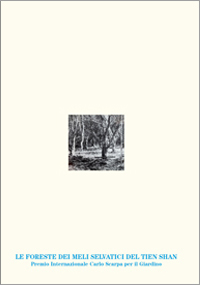
The wild apple forests of the Tien Shan
The International Carlo Scarpa Prize for Gardens 2016
XXVII edition
edited by Giuseppe Barbera, Patrizia Boschiero, Luigi Latini, with Catherine Peix
Fondazione Benetton Studi Ricerche
Treviso, 2016
172 pages, 185 illustrations in colour and 79 black and white
ISBN 978-88-99657-06-2.
Italian edition, ISBN 978-88-97784-95-1
(series Memorie/dossier)
The monographic dossier contains about twenty unpublished essays and is richly illustrated with historical and current photographs – mainly taken by Catherine Peix during her numerous expeditions to the Tien Shan – of the designated site and the many questions raised by this. As usual, the dossier also provides some cartographic documentation and a range of bibliographic references for further study.
After the first section most directly related to the Carlo Scarpa Prize and its explanation, there is a section of six essays dedicated specifically to the Malus sieversii and its forests in the Tien Shan, to the historical and geographical context of Kazakhstan and the broader one of the silk roads, then looking at the key figure of the scientist Aimak Dzangaliev and the Alma Association, which safeguards and promulgates his work.
There are then four essays by scholars who from different disciplinary points of view look at what may synthetically be defined as the relationship, always vibrant and complex, between the trees, the landscape and man. Economics, politics and techno-sciences also have much to do with the history and topicality of these forests, and with our look at the wild apple trees, the “wild” compared to the “cultivated”.
Finally, some windows on the apple and the apple tree open more directly onto some specific European contexts of current apple growing in Trentino-Alto Adige, on agro-ecology experiences in France and on the apple landscape of the Appenines, to end, thanks to a study on the Vavilov Institute of Saint Petersburg, with some reflections on a global view of the world’s genetic resources.
Contents
The International Carlo Scarpa Prize for Gardens 1990-2016, 4
Regulations and Scientific Committee, 5
The wild apple forests of the Tien Shan. Citation of the Carlo Scarpa Prize, 6
Catherine Peix, Malus sieversii: the wild species that gave origin to the cultivated apple, 17
Natalya Ogar, Distribution of the wild apple tree and its growth conditions in the Tien Shan, 25
Natalya Ogar, Kazakhstan. Geographical and historical synthesis, 36
Massimo Rossi, The ancient Silk Road, great empires and the migration of apples, 43
Tatiana Salova and Catherine Peix, The human and scientific story of Aimak Dzangaliev (1913-2009), “father” of Malus sieversii, 49
Catherine Peix, The Alma Association, 57
Silviero Sansavini, The pome, the tree, the orchard: origin and evolution in apple growing, 63
Giuseppe Barbera, Apple tree landscapes, 71
Diego Rivera and others, Domestication and conservation of wild fruit tree in Eurasia, 87
Hervé Brunon, A discourse by a “wild” apple tree, or the capacity to act of plants, 97
Joan Vicente i Rufí, Central Asia and the new Silk Road. Geopolitics as palimpsest, 103
Catherine Peix, Nikolai Vavilov and Trofim Lysenko: “the war of the two sciences”, 111
Francesco Sottile, Genetic manipulations, economies, landscapes, biodiversity, 124
Massimo Tagliavini, Wolfgang Drahorad, Andrea Fedrizzi, The apple in the Alpine valleys of Trentino-Alto Adige, 127
Fabrizio Fronza, Apple growing in Trentino, 132
Évelyne Leterme, Agroecology and biodiversity, an orchard’s best friends, 141
Isabella Dalla Ragione, The apple tree in the Apennine landscape, between history and culture, 147
Catherine Peix, Vavilov and his institute. A global vision of the world’s wild and cultivated genetic resources, 152
Bibliography, 162
Illustration references, 166
List of authors, 167
International Carlo Scarpa Prize for Gardens 2016, 168
